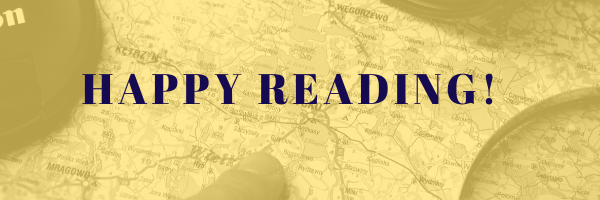
This blog post contains affiliate links. All reviews and opinions are my honest experience, but if you make a purchase through these links, I may receive a commission (at no cost to you).
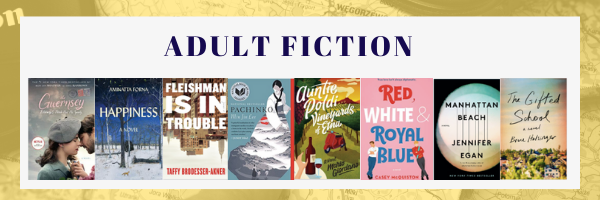
- The Guernsey Literary and Potato Peel Pie Society: A writer looking for the topic of her next book happens about a community of people in Guernsey, in the Atlantic Channel. Guernsey, technically a part of England, was occupied by Nazis during World War II (little known history!). This small band of citizens formed a ‘literary society,’ where they’re able to bond over books and share some brightness against the bleak backdrop of Nazi occupation. After the war, the writer travels to Guernsey to learn more about these folk.
- Why I loved it: Think of this book as “if Jane Austen wrote a novel set in WWII.” It’s delightfully funny and there’s an irresistible love story at its core! As well as a mystery with real emotional heft. It’s an epistolary novel (told in letters)–you can TEAR through this one. It’ll leave you with a smile.
- Happiness: Two strangers have a chance encounter: Attilla, a Ghanian psychiatrist, is in London for a brief stay, to give a keynote address, and Jean, an American studying the foxes in London (Fleabag much?). In the bustle and hugeness of London, these two share an unexpected connection over the course of several days.
- Why I loved it: I’m a sucker for ‘unexpected moments of connection stories’ (see also in film: the ‘Before’ trilogy by Richard Linklater, the book The Sun is Also a Star by Nicola Yoon). Attila and Jean’s personal histories are woven throughout the story, which is about second chances and new possibilities and the nature of happiness itself.
- Fleishman is in Trouble. Toby Fleishman, recently divorced hepatologist, is in a quandary. His ex-wife has gone missing, meaning his every other weekend with the kids has been extended. This is interrupting his amorous activities in the virtual playground of online dating apps–a newfound wonderland where the women want him and don’t mind his (lack of) height. Where’d his ex-wife Rachel go? It’s a mystery–as is the true nature of the true nature of his 13-year marriage.
- Why I loved it: Can you say unreliable narrator? Toby has painted himself as the aggrieved, responsible partner, while Rachel is the ruthless one, the mother who’s at risk of screwing up her kids and husband thanks to unbridled ambition. Yet things may not be what they seem. Add to this mix lines that had me suppressing cackles, and then wiping away tears. Fleishman is flat-out fantastic.
- Pachinko. Sunja is the daughter of a desperately poor fisherman and innkeeper in Korea. When she becomes pregnant at a young age, her situation is dire; until a kindly missionary passing through the family inn offers to marry her. Together, they travel to Japan and begin a new life together. Pachinko tells the epic story of Sunja’s family through the generations.
- Why I loved it: ‘Multi-generational family epic’–need I say more? You had me at hello! I loved the historical element in this: I learned so much about the relations between Japan and Korea, what it was like to inhabit both places pre, during, and post World War II. If you want a book to take you on a journey, this is the one.
- Auntie Poldi and the Vineyards of Etna. Auntie Poldi is a Bavarian in Sicily; she moved there to enjoy retirement and “drink herself to death with a sea view.” There’s just one problem: she can’t keep her nose out of crime. When neighborhood dog is poisoned and the town water supply is cut off, Poldi knows it’s the Mafia making a dare. Yet Poldi is never one to resist a dare.
- Why I loved it: This is my second Auntie Poldi read (see also: Auntie Poldi and the Sicilian Lions). She’s irresistible: boozy, wig-bedecked, big-bosomed, funny, with a torch for the local police inspector and rival in crime-solving. The Auntie Poldi books are told with no small amount of charm and humor, and I love learning about Sicily (the food! the scenery!). A delightful summer-or-anytime read.
- Red, White, and Royal Blue. The president’s son has fallen in love. . .with the prince of England. One’s treated like royalty, one’s actual royalty. Both have everything on the line. Alex Claremont-Diaz, First Son and political whiz kid, is contemplating his future career and strategizing for his mother’s re-election. Prince Henry has thousands of years of stuffy tradition on the line–a tradition not so kind to those who don’t conform to outdated gender roles. Can love survive?
- Why I loved it: Think of this as West Wing meets the House of Windsor. DELICIOUS. I gobble up anything having to do with presidential history, and the love story between Alex and Henry will charm the pants off you. It’s funny as all heck, too. Bonus: Red, White, and Royal Blue presents an alternate history. What if a woman had won the 2016 presidential election? Alex’s mom, the president, is a Texan, so there’s lots in here about Texas and its political landscape. As a Dallas-ite, I ate it up.
- Manhattan Beach. When Anna Kerrigan is 12 years old, her life is set in motion when she accompanies her father to Manhattan Beach and the home of mysterious tycoon Dexter Styles. Anna’s father disappears, and the country goes to war. Anna, captivated by the sea, becomes the first female diver to repair the ships America sends across the ocean to bring victory to the Allies. As a young woman, she’s drawn again into the world of Dexter Styles, gangsters, the seedy underbelly of New York City–and how these things might relate to her missing father.
- Why I loved it: I’m always a sucker for books set in New York, and I was fascinated by this portrait of the city in wartime. Anna’s fascination with the sea hooked me, as well as the impressive physicality required of her to become a diver. The scenes under the sea are spellbinding, and the mystery of her father’s disappearance keeps the pages turning.
- The Gifted School. In the idyllic, upper middle class town of Crystal, Colorado, four families and their children live in relative peace–until a school for the ‘profoundly gifted’ opens nearby. Suddenly, the gifted school is all anyone can think or talk about. Friendships fracture and long-buried secrets are revealed as these parents stop at nothing to secure the best future–’for the kids.’
- Why I loved it: Keenly observed, biting, at turns dark and then hopeful, sarcastic, funny, genuinely surprising and ultimately redemptive. An examination of what drives parents and children and where the lines blur between the two sets, with an unstoppable pace.
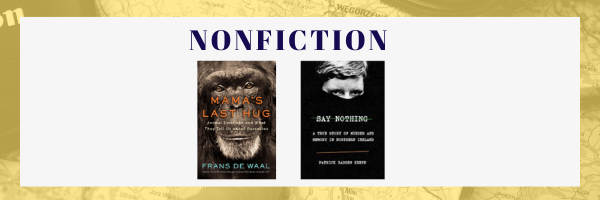
- Mama’s Last Hug. This book takes its name from a video that went viral. When ‘Mama,’ matriarch of a chimpanzee colony, was sick and near death, she was visited inside her enclosure by biologist Jan van Hooff, her longtime friend. Mama greeted van Hooff with an enormous grin and a remarkably human embrace. Frans de Waal, primatologist, uses this story as a jumping off place to explore the continuum of animal emotions, making the case that all emotions experienced by humans are also experienced by animals.
- Why I loved it: Whether or not you consider yourself an animal lover, this book is fascinating. What is the emotional life of a fish like? Why is being alpha male of a chimp colony similar to being president–aka, full of stress? What’s the difference between the social structures of chimpanzees and their cousins the bonobos, and why have human societies paid so much attention to chimpanzees and so little to bonobos (hint: sexism)? Read this book to have these questions–and more–answered.
- Say Nothing: A True Story of Murder and Memory in Northern Ireland. This examination of The Troubles in Northern Ireland starts with a mystery: Jean McConville, mother of 10, is dragged from her home by masked intruders as her children look on. More and more pieces of the mystery are revealed as the author examines the key players in Troubles and traces their activities–and the casualties of those activities–through multiple decades.
- Why I loved it: Part true crime, part social and political history, part cultural anthropology. I knew almost nothing about The Troubles–the period of conflict in Northern Ireland between the Protestant majority and the Catholic minority–before reading this. Yet Patrick Radden Keefe paints recent history so vividly; the tension of The Troubles–that carries over into this present day–pulses like a beating heart.
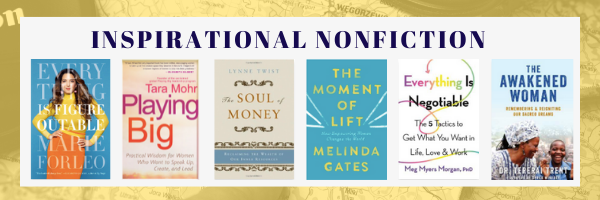
- Everything is Figureoutable. Marie Forleo built an eight-figure company out of nothing with one simple belief at its core: everything is figureoutable. In this book, Marie helps you identify your biggest priorities, then break down the steps that will lead you to your end goal. There is always a right action to take: this book will help you take it.
- Why I loved it: ‘Everything is figureoutable’ has become one of my new, go-to mantras. It’s amazingly helpful, whether I feel overwhelmed about the best method for cleaning up a messy playroom or am trying to work out how to scale my business. I especially loved the ‘Figureoutable Field Notes,’ in which real people tell of how they overcame stuckness and figured out their most pressing problems.
- Playing Big. Tara Mohr has coached hundreds of women leaders, and found that many of them were too bound by other’s expectations of them to embrace their true callings and be all they were meant to be in the world. Playing Big provides a guidebook for women who want to grow into their fullest selves.
- Why I loved it. Playing Big will force you to question: where am I playing small? Is this because I want to be, because I think I need to be, or because of some unconscious conditioning I’m not even aware of? This book is for you if you believe you’re meant to thrive in your motherhood, relationships, financial life, career. . .ALL of it.
- The Soul of Money. Lynne Twist is a fundraiser by profession. Her experience raising money for people in the most vulnerable of circumstances–as well as her own personal history with money–have caused her to think deeply about our relationship with our finances. Twist examines how we can move from feelings of scarcity of guilt to feelings of sufficiency and abundance.
- Why I loved it: ‘Money’ is never just ‘money.’ Our feelings about money create our experiences of money, regardless of what our bank account balances say. This book will drive that truth home. Twist also tells remarkable stories from people she’s met from her travels around the world that you’ll be hard-pressed to forget.
- The Moment of Lift. If you want to improve a society, invest in women. Continuing in the tradition of Half the Sky, Melinda Gates places herself at the forefront of female empowerment in The Moment of Lift, which details the Gates’ foundation years of research and investment into programs which will enhance the lives of the most vulnerable members of our global community–namely, women living in impoverished conditions.
- Why I loved it. Gates investment and interest in bettering the lives of women is the real deal; she’s taken great personal pains–including ostracism from her Catholic community for her commitment to making birth control measures available to all–to do this work. Gates’ stories will compel you, break your heart, and give you hope. You’ll be galvanized to join her in the work.
- Everything Is Negotiable. Dr. Meg Myers Morgan runs a graduate program; in this position, she’s counseled hundreds of people to help them determine their next professional steps. Many of these people are young women, conditioned to make themselves ‘small’ in order to fit society’s pre-ordained boxes–and leave certain elements of wholeness and happiness on the table. Yet everything is negotiable, even the futures we’ve been taught to aspire to. It’s our duty to negotiate–our happiness hangs in the balance.
- Why I loved it. Everything Is Negotiable is told with heaping amounts of humor and practicality. Similar to ‘everything is figureoutable,’ ‘everything is negotiable’ provides a framework for life that allows you to square your shoulders, take a deep breath, and take whatever next step is beckoning.
- The Awakened Woman. Tererai Trent was a teenaged mother of four in war-torn Zimbabwe, poverty-stricken, desperate, in a marriage that felt like a prison sentence. Here she dreamed an impossible dream: to go to America and get an education. And not just any education–Tererai, who had no high school diploma, wanted her Ph.D. She wrote her dreams down on a scrap of paper, placed them in a can, and buried them in the dirt. The Awakened Women is her remarkable story.
- Why I loved it. Are you harboring a dream that seems impossible? Dr. Trent’s was more impossible. Yet through faith, unending patience, and perseverance, Tererai held fast to the phrase ‘Tinogona’–it is achievable–and. she. did. it. Tip: Listen to the audiobook and allow yourself to fall under the sway of Tererai’s melodic, soul-stirring voice.
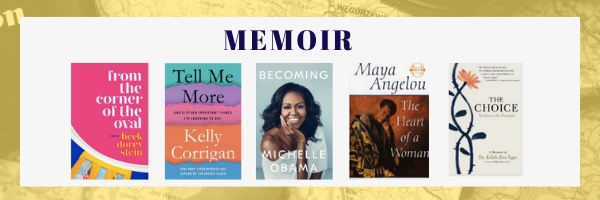
- From the Corner of the Oval. Beck Dorey-Stein is desperate to find a job that will allow her to stay in uber-expensive Washington DC when she happens upon a Craigslist ad. Little does she know that the job being advertised is for a role in President Obama’s White House as a stenographer. Beck gets the gig: what follows is an up-close, six-year look at living history.
- Why I loved it. Beck Dorey-Stein doesn’t try to hide her starry-eyed admiration of Barack Obama; whenever he appears on the scene, it’s like the Beatles have landed. From the Corner of the Oval is a workplace dramedy where the boss is none other than the leader of the free world. . .and they happen to ride on Air Force One every now and then. (The writing is stellar, too.)
- Tell Me More: Stories About the 12 Hardest Things I’m Learning to Say. Kelly Corrigan has set out to name the phrases that make love and connection possible, from “I’m Sorry,” to “No,” to “I don’t know,” and of course, “Tell me more.” These phrases from the backdrop to stories of love and loss and friendship and everyday grace in this deeply affecting memoir.
- Why I loved it: I’m not a book cryer, but the tears STREAMED in this one. I could cry just thinking about it now. It’s not all melancholy, though–I laughed as much as I cried. Kelly Corrigan has been called “the poet laureate of the ordinary.” After reading Tell Me More, I can say: the title fits. Just beautiful.
- Becoming. In Becoming, Michelle Obama tells her remarkable journey from the Southside of Chicago to 1600 Pennsylvania Avenue. It’s a deeply personal, marvelously told account of her triumphs and setbacks, her deepest tragedies and most profound joys.
- Why I loved it: I cried in this one too, folks! Mrs. Obama suffered some devastating losses; you’ll grieve right along with her and her family. Yet Becoming is also funny and eminently empowering. I read it and took mental notes–on how to prioritize friendship, how to ask for what you really want in the workplace, how to raise great kids, and how to make a marriage work in the most extreme of circumstances.
- The Heart of a Woman. The Heart of a Woman opens with Maya Angelou living in San Francisco with her young son, working as a singer and dancer. From there, the book chronicles as she moves across the country–and the world–in search of her destiny. The Heart of a Woman is peopled with luminaries as bright as Maya herself, from Malcolm X to James Baldwin to Billie Holiday to Martin Luther King Jr.
- Why I loved it. A brilliant personal narrative that also gives an up-close look at one of the most turbulent times in recent American history–the Civil Rights movement. If you’re under the tyranny of thinking you need to have it all “figured out” at a young age, look to Ms. Angelou, who brilliantly navigated multiple careers, cities, languages, etc. Throughout it all she strove to remain true to herself, and thus lit the way for many, many women to follow.
- The Choice: Embrace the Possible. Edith Eger is a 16 year old ballerina and gymnast when the Holocaust descends upon her family. Along with her mother, father, and sister, Edith is sent to Auschwitz, where she is compelled to dance for Josef Mengele–aka, “Dr. Death.” Edith’s harrowing account of survival–and her remarkable life that follows–is a testament to the human spirit’s ability to endure and even thrive amidst the bleakest of conditions.
- Why I loved it. I’m quite sure you’ve never met anyone like Edith Eger. Her story is horrifying, compelling, and awe-inspiring. Perhaps more remarkable than Edith’s survival of Auschwitz is the life she was able to build herself afterward, as a psychiatrist who helped hundreds of thousands of people over decades. She wrote this memoir in her 90’s (!); her indomitable spirit and grace are still changing lives.

- The World Ends in April. Eleanor may not know how to navigate the socially complex world of middle school–but thanks to a survivalist grandpa, she’s an EXPERT on the end of the world. Eleanor comes across a website where a Harvard physicist has predicted that an asteroid will collide with Earth on April 7. That’s just a few months away; Eleanor must make sure her family is prepared, as well as her best friend, Mack. But Mack may be going to a special school for the blind in the fall–TEOTWAWKI (The End of The World As We Know It) looks like it’s coming for Eleanor, one way or another.
- Why I loved it: Eleanor is a lovably “unlikeable” heroine–cranky, stubborn, defiant. She forges unlikely friendships with some equally misfit kids. Ever been CONVINCED of something, and desperate to strong-arm people into your worldview (just me??). If so, you’ll relate to Eleanor’s journey, and the freedom she ultimately finds.
- Up for Air. 13 year old Annabelle struggles in school, and doesn’t fit in with her successful mother and stepfather. The one place she feels at home is in the water. But the summer before eighth grade, she finds herself in over her head. There’s an older boy who’s suddenly giving her attention, and Annabelle will do anything to be close to him–even blow off her old friends and go along with a prank that could have serious consequences.
- Why I loved it: Remember being 13 and thinking you needed to change every little thing about yourself–veering between confidence and utter self-loathing with every moment? Oof. I’ve tried to block out those memories, but this book brought them back in cringeworthy fashion. Ultimately, Annabelle is able to find grace for herself–maybe you’ll find a little grace for middle school (or present-day) you, too.
- Sweep: The Story of a Girl and Her Monster. Nan is a chimney sweep in Victorian London. An orphan, she’s at the mercy of her master, a sweep who mercilessly exploits the children in his charge. One day she’s caught in a deadly accident; yet when she wakes up, she’s in an attic with a mysterious creature–a golem made of ash and and coal. Together, Nan and the creature must save each other and find their place in a harsh world.
- Why I loved it: If you’ve ever bought into the ‘carefree chimney sweep’ myth (a la Bert in Mary Poppins). . .think again! The world of the Victorian chimney sweep was unremittingly cruel. Your heart will break at the plight of Nan and her companions, then be mended by the relationship between Nan and her golem, the moments of mercy and redemption. Sweep is wrenching, beautiful, and impossible not to fall in love with.
- Song for a Whale. Iris, a deaf girl, learns in school about Blue 55, a whale who travels through the ocean alone, unable to speak to other whales. Iris knows what it’s like to be unable to communicate freely. She hatches a brilliant plan: Iris will use her knowledge of fixing up old radios to create a ‘song’ on the frequency that Blue 55 can hear–and she’ll sing to him! Will she be able to play Blue 55 her song?
- Why I loved it: There’s a magical element to this book, which is grounded in science. Iris is irrepressible and irresistible, a heroine to cheer for. Song for a Whale has a cross-country adventure, as Iris tries to reach her whale. I also learned so much about Deaf culture, which was fascinating (yay for representation!).
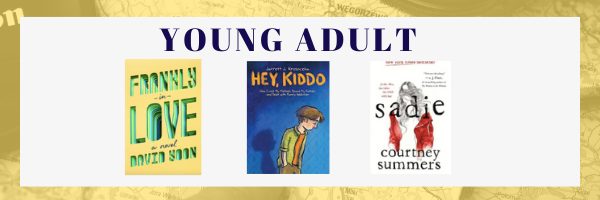
- Frankly In Love. Frank Li is a first-generation American, the son of Korean immigrants, who have one rule when it comes to dating: ‘date Korean.’ When Frank falls for a white girl, a solution presents itself: he can fake date his friend Joy–who’s also in a relationship of which her parents don’t approve. Yet Joy may be more than the ‘friend’ Frank has always taken her for.
- Why I loved it: There’s a love triangle in this one, but this book is about so much more than who dates whom. It’s really about family: Frank’s immigrant parents, their hard work and unwavering dedication to Frank’s future, how Frank navigates their suffocating love and prejudices, what really matters in the end. . .Frankly in Love is a surprising, satisfying journey.
- Hey Kiddo. This graphic novel memoir tells the story of Jarrett. Jarrett’s father’s identity is a mystery, and his mother is an addict. Jarrett’s grandmother and grandfather step in to fill the parental role–two loving, loud, irascible and loving individuals who thought their child-rearing days were over.
- Why I loved it: The visuals are stunning, and the family drama is compelling. You’ll feel as if you’re part of Jarrett’s family and fall in love with his grandpa and grandma. Hey Kiddo is also about how art helps us find our place in an uncertain world; with chaos swirling around him, Jarrett finds solace in drawing and holds to big dreams for his future.
- Sadie. Life is not easy for Sadie, who’s raised herself and her little sister Mattie, essentially on her own. When Mattie is found dead, Sadie doesn’t have many clues to follow. Yet she takes off, determined to exact revenge on the killer. A podcaster gets wind of the chase and obsessed with Sadie’s story. Where did Sadie go? And will she end up another dead girl.
- Why I loved it: Propulsive and heart-stopping, Sadie alternates point of view between Sadie herself and West McCray, the podcaster who’s relaying Sadie’s story Serial-style. Sadie’s tale is grim and harrowing, yet absolutely un-put-downable. Prepare to hold your breath.

- E Squared: Nine Do-It-Yourself Energy Experiments That Prove Your Thoughts Create Your Reality. ‘We don’t experience reality, we create it.’ That’s the premise of this little book, which doubles as a ‘lab’ by which the reader can test the truth of this statement. The experiments are fun (and free!): their primary value is that they encourage you to examine where you put your focus. What you focus on, you create more of.
- Why I loved it: E Squared takes a playful approach to creating the life you desire. Life is a game–why not enjoy it? Author Pam Grout writes with the voice of a hilarious older sister; she shares some truly head-scratching stories from her own life and the lives of her friends. You’ll question things you previously thought unquestionable–and enjoy it.
- It’s Not Your Money: How to Live Fully from Divine Abundance. If you’re a spiritual seeker, you’ve likely read enough material on ‘manifestation’ to fill several libraries. This is a topic that can be both inspiring and demoralizing. Yet ‘manifestation’ doesn’t stop the insatiable urge for more. In It’s Not Your Money, Tosha Silver offers a different approach: offer everything, including our finances, to Love. This offering may just be the secret to abundance.
- Why I loved it. Again–’money’ is never just about money. How we view money says a lot about how we view ourselves. Tosha Silver offers a way of radical acceptance and love for ourselves and our finances, and reminds us that we can always ask Love (God) for help, no matter how ‘small’ the situation. This book sits permanently on my nightstand now: the ‘Abundance Change Me’ prayer is hanging on my bathroom mirror, and I can recite it by memory.
- The Science of Getting Rich. Wallace Wattles makes a case of achieving prosperity: he says that it is the natural unfolding of life, and that longing for wealth is akin to the tree that longs to grow. In this slim volume, Wattles encourages the reader to visualize the life she wants and to “live mentally in this house,” all the while expressing gratitude, which keeps us connected to God.
- Why I loved it. You can read this slim volume in an hour, but be sure you account for all the time it will take to underline sentences (or copy them in your journal). I copied pages and pages of quotes and refer back to them weekly. A year ago I wouldn’t have read this book! I would have been too put off by the title. The focus of this book may be tapping into wealth, but it’s really about how to create the life you want–no matter how little or how much money that may require.
